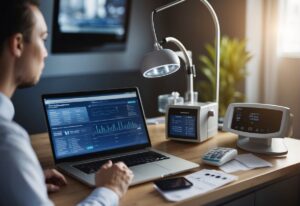Wearable sleep trackers have become increasingly popular in recent years as people look for ways to understand and enhance their sleep patterns.
These devices offer a convenient and non-invasive way to monitor sleep, providing users with insights into their sleep quality and duration.
By tracking sleep patterns over time, wearable sleep trackers can help users identify trends and make informed decisions about how to improve their sleep health.
Understanding sleep patterns is essential for maintaining good health. Not getting enough sleep can lead to a range of health problems, including obesity, diabetes, and heart disease.
Wearable sleep trackers offer a way to monitor sleep patterns and identify potential issues before they become serious problems.
By tracking metrics such as sleep duration, sleep quality, and heart rate variability, these devices can provide users with a comprehensive picture of their sleep health.
The rise of wearable sleep trackers has been driven by advances in sensor technology and the increasing popularity of wearable devices.
Today’s wearable sleep trackers are more accurate and reliable than ever before, offering users a wealth of data about their sleep patterns.
As the technology continues to evolve, we can expect to see even more sophisticated sleep tracking devices that offer new insights into sleep health.
Key Takeaways
- Wearable sleep trackers offer a non-invasive and convenient way to monitor sleep patterns and identify potential health issues.
- Understanding sleep patterns is essential for maintaining good health and preventing a range of health problems.
- Advances in sensor technology and the increasing popularity of wearable devices have driven the rise of wearable sleep trackers.
Understanding Sleep Patterns
The Importance of Sleep Quality
Sleep quality refers to the degree to which a person’s sleep is restful, restorative, and uninterrupted. Good sleep quality is essential for optimal health and well-being.
Poor sleep quality can lead to a range of negative health outcomes, including obesity, diabetes, heart disease, and depression.
Wearable sleep trackers can help individuals understand their sleep patterns and identify potential areas for improvement.
By tracking sleep time, sleep stages, and other sleep-related metrics, individuals can gain insights into their sleep quality and make changes to improve it.
Stages of Sleep
Sleep is divided into several stages, each with its own unique characteristics. These stages are typically measured using electroencephalography (EEG) and other physiological measures.
The first stage of sleep is light sleep, during which the body begins to relax and the brain produces theta and alpha waves. This stage typically lasts for 5-10 minutes.
The second stage of sleep is characterized by the presence of sleep spindles and K-complexes. This stage typically lasts for 20-30 minutes.
The third and fourth stages of sleep are collectively known as slow-wave sleep (SWS). During this stage, the brain produces delta waves, and the body undergoes restorative processes such as tissue repair and growth hormone secretion.
The final stage of sleep is REM sleep, during which the brain becomes highly active, and the body undergoes rapid eye movements. REM sleep is believed to be important for memory consolidation and emotional regulation.
By tracking sleep stages using wearable sleep trackers, individuals can gain insights into their sleep patterns and identify potential areas for improvement.
For example, if an individual is not getting enough slow-wave sleep, they may need to make changes to their sleep environment or bedtime routine to improve their sleep quality.
The Rise of Wearable Sleep Trackers
Wearable sleep trackers have revolutionized the way people monitor their sleep patterns.
These devices, which are worn on the wrist, finger, or head, use accelerometers and other sensors to detect movement and other physiological signals during sleep.
The data collected can then be analyzed to provide insights into sleep quality, duration, and other metrics.
Types of Wearable Devices
There are several types of wearable devices available on the market that can help monitor sleep patterns. Some of the most popular types include:
- Fitness Trackers: These devices are designed to track physical activity, including sleep. They typically use an accelerometer to detect movement during sleep and provide basic sleep metrics such as total sleep time and sleep efficiency.
- Smartwatches: These devices offer more advanced sleep tracking features, including heart rate monitoring, sleep stages, and snoring detection. They also offer other features such as notifications, music playback, and GPS tracking.
- Headbands: These devices use EEG sensors to monitor brain activity during sleep and provide more detailed information about sleep stages and quality.
Features and Functions
Wearable sleep trackers come with a range of features and functions that can help users better understand their sleep patterns.
- Sleep Tracking: This feature detects movement and other physiological signals during sleep to provide metrics such as total sleep time, sleep efficiency, and sleep stages.
- Heart Rate Monitoring: This feature uses sensors to monitor heart rate during sleep and can provide insights into sleep quality and overall health.
- Smart Alarms: These alarms use data from sleep tracking to wake users up at the optimal time, based on their sleep cycles.
- Sleep Coaching: Some devices offer personalized coaching and recommendations to help users improve their sleep habits.
Measuring Sleep: Methods and Metrics
Polysomnography vs. Wearables
Polysomnography (PSG) is the gold standard for measuring sleep. PSG involves monitoring brain waves, eye movements, muscle activity, heart rate, and breathing patterns.
PSG is highly accurate and provides detailed information about sleep stages and sleep disorders. However, PSG is expensive, time-consuming, and requires a sleep laboratory.
Wearable sleep trackers, on the other hand, are much more convenient and affordable.
Wearables use actigraphy, which involves measuring movement to infer sleep. Wearables are able to estimate sleep duration, sleep efficiency, and time spent in different sleep stages.
However, wearables are less accurate than PSG, and their algorithms for sleep staging may vary between devices.
Actigraphy and Algorithms
Actigraphy is a non-invasive method of monitoring sleep using a device worn on the wrist. Actigraphy devices measure movement and use algorithms to estimate sleep stages.
Actigraphy is a valid method for measuring sleep, but its accuracy varies between devices and algorithms.
Some wearables use machine learning algorithms to improve their accuracy.
Machine learning algorithms can learn from large datasets to make more accurate predictions about sleep stages. However, the accuracy of machine learning algorithms depends on the quality and quantity of the data used to train them.
Analyzing the Data: Accuracy and Validation

Assessment of Sleep Disorders
Wearable sleep trackers are becoming increasingly popular as a tool for monitoring sleep patterns.
They can provide valuable insights into how long and how well a person is sleeping, as well as identifying any potential sleep disorders. However, it is important to assess the accuracy and reliability of these devices before relying on them for diagnosing any sleep disorders.
One way to assess the accuracy of wearable sleep trackers is by comparing their results with the gold standard for sleep monitoring, which is polysomnography (PSG).
PSG involves monitoring various physiological signals during sleep, such as brain waves, eye movements, and muscle activity, to accurately determine sleep stages and identify any sleep disorders.
Comparison with Gold Standard
A study conducted by researchers at the University of Glasgow compared the accuracy of six different wearable devices in estimating sleep stages and heart rate variability with PSG.
The study found that while the wearable devices were generally accurate in detecting total sleep time, they were less accurate in identifying specific sleep stages, such as REM sleep.
Furthermore, the study found that heart rate variability, which is a measure of the variation in time between heartbeats, was not accurately captured by the wearable devices.
This is an important measure for assessing the quality of sleep and identifying any potential sleep disorders.
To enhance the reliability of wearable sleep trackers, it is important to validate their algorithms with equity, diversity, and inclusion considerations.
This can ensure that the devices are accurate across different populations and demographics.
Improving Sleep Health with Wearables

Wearable sleep trackers have become increasingly popular in recent years as a tool for monitoring and improving sleep quality.
By providing users with data on their sleep patterns, these devices can help individuals identify areas where they can make lifestyle changes to improve their sleep hygiene.
In addition, machine learning algorithms can be used to analyze this data and provide personalized recommendations for improving sleep quality.
Lifestyle Changes and Sleep Hygiene
One of the primary benefits of wearable sleep trackers is that they can help users identify behaviors that may be negatively impacting their sleep quality.
For example, if a user notices that they consistently have a low sleep score on nights when they consume caffeine late in the day, they may choose to avoid caffeine after a certain time to improve their sleep quality.
Similarly, if a user notices that they tend to have a better sleep score on nights when they exercise, they may choose to incorporate more physical activity into their daily routine.
Wearable sleep trackers can also help users establish good sleep hygiene habits.
For example, many devices include features that remind users to go to bed at a consistent time each night and to avoid using electronic devices in the bedroom.
By establishing a consistent sleep schedule and creating a sleep-conducive environment, users can improve their sleep quality over time.
The Role of Machine Learning
Machine learning algorithms can be used to analyze the data collected by wearable sleep trackers and provide personalized recommendations for improving sleep quality.
For example, these algorithms can identify patterns in a user’s sleep data and suggest changes to their sleep hygiene habits that may improve their sleep quality.
In addition, machine learning can be used to detect sleep disorders such as sleep apnea and insomnia, which can be treated with targeted interventions.
Overall, wearable sleep trackers have the potential to be a valuable tool for improving sleep health.
By providing users with data on their sleep patterns and personalized recommendations for improving sleep quality, these devices can help individuals identify areas where they can make lifestyle changes to improve their sleep hygiene.
In addition, machine learning algorithms can be used to analyze this data and provide targeted interventions for sleep disorders.

